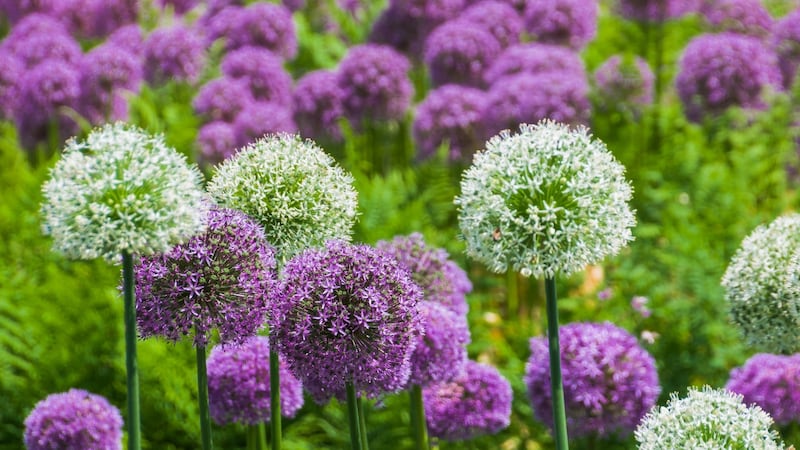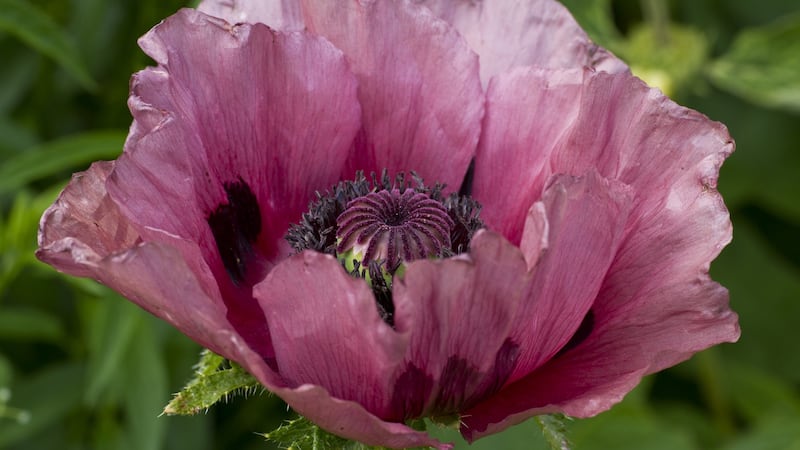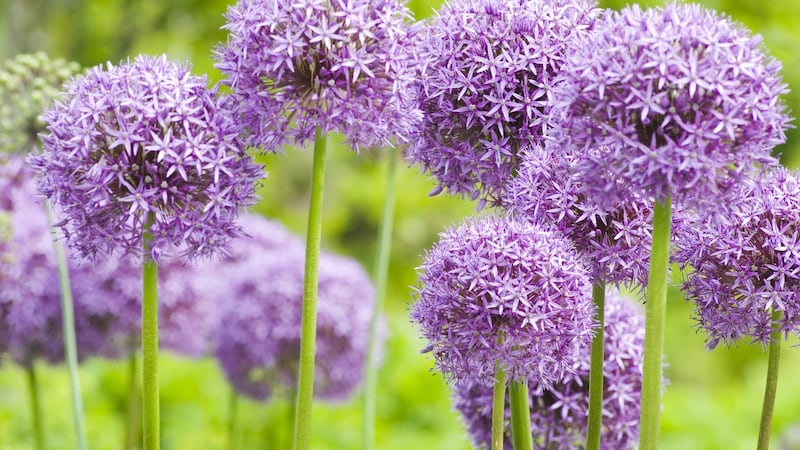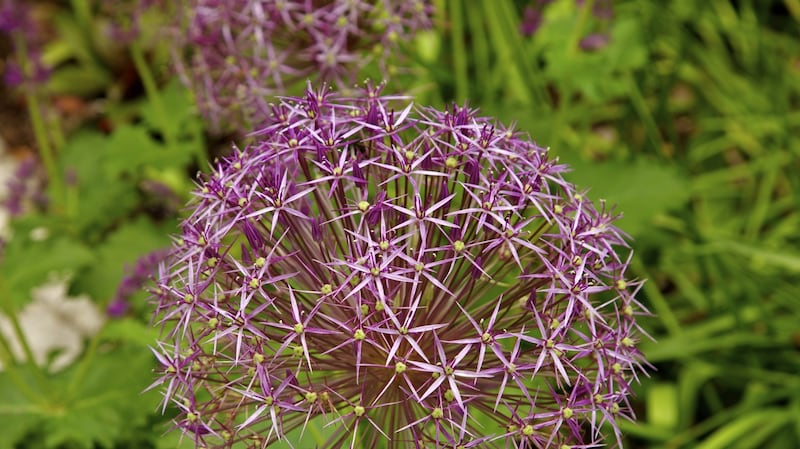Mention the word alliums and many of us will instantly think of the many different edible members of the onion family, from chives (Allium schoenoprasum), leeks (Allium ampeloprasum) and garlic (Allium sativum) to native or naturalised species such as wild onions (Allium vineale) and ramsons (Allium ursinum).
But of course there are also lots of kinds of ornamental onions that are prized by gardeners for their hugely decorative, pollinator-friendly, drumstick-shaped flowers which come in shades of purple, silvery-pink and white as well as blue and yellow.
Easy to grow from bulbs planted into the border or into pots at this time of year, most are tolerant of a wide range of growing conditions and will bring a very welcome flash of jewel-like colour to the late spring and summer garden.
Typically coming into bloom in May-June, these ornamental alliums combine very well with other early-blooming perennials such as aquilegia, bearded irises, lupins, geums and oriental poppies, as well as biennials such as lunaria, sweet rocket and foxgloves.
Their slender stems and sculptural, globe-like flowerheads or umbels also work brilliantly when planted into formal box parterres or used to add some drama to the quieter charms of foliage plants including artemisia, ferns, hostas and ornamental grasses.
Ornamental alliums can also make excellent cut-flowers (just make sure to change the water regularly as their freshly-cut stems can give off an oniony pong) while their sculptural seed-heads make a fantastic addition to a dried flower bouquet or arrangement.
Best known (and one of the most affordable when it comes to buying the bulbs for autumn planting) is the enduringly popular Allium hollandicum ‘Purple Sensation’, a hardy, reliably perennial, long-lived and obligingly easy-to-grow self-seeder with large, graceful, violet-purple flowers that appear in early June just as tulip season comes to an end.
Self-seeded plants will often naturally revert to the species’ somewhat paler colour, resulting in an eye-pleasing mix of flowers in varying shades of violet-purple that slowly fade to jade-green as the long-lasting seed-heads begin to form. While happiest in full sun and a fertile, moisture-retentive but free-drained soil, this versatile variety is surprisingly tolerant of light shade and looks especially wonderful planted in generous drifts.
Star of Persia
Slightly later and longer-flowering is the award-winning Allium 'Purple Rain', a cross between A 'Purple Sensation' and Allium cristophii (commonly known as Star of Persia) that combines the height and richness of colour of the former with the much more open, starry-shaped blooms of the latter. A relatively new introduction, it was singled out for special mention at a recent trial of alliums by the UK's Royal Horticultural Society.
As is so true of Allium cristophii, the flowers of other varieties of ornamental alliums are not so much globe-shaped as reminiscent of exploding fireworks, with a strange, otherworldly, attention-grabbing beauty that works particularly well when they’re grown in pots or containers.


Examples include the spectacular Allium schubertii, whose lilac blooms appear in June, each giant umbel covered in a multitude of tiny, star-shaped flowers held aloft on rigid, lime-green spokes.
Another is Allium carinatum subsp pulchellum, a species native to the Mediterranean with enchantingly pretty violet flowers that look like a constellation of tiny, shooting stars.
For something special (forgive its unwieldy name), seek out the white-flowered form, Allium carinatum subsp pulchellum f album. Or for something guaranteed to provoke discussion as to its debatable charms, seek out Allium ‘Dready’, a very eccentric variety with a Medusa-like flowerhead of tangled lime-green tendrils reminiscent of miniature dreadlocks (hence the varietal name) that gradually turn to wine-red as they age.
Other show-stopping varieties of ornamental allium are impressively statuesque in their proportions such as Allium ‘Globemaster’, a well-known late-June/July-flowering variety with giant, spherical, silver-lilac, long-lasting flowerheads that can measure up to 15cm in diameter and reach an average height of 80cm.
Bigger again are Allium ‘His Excellency’ (90cm, May-June flowering), and Allium ‘Gladiator’, a lofty and robust variety with violet, drumstick flowers in June that reach a height of 1.5 metres.
Others are subtle and more understated in their beauty, lending themselves to more naturalistic, meadow-style plantings. Examples include the lovely Allium siculum subsp bulgaricum (formerly known as Nectaroscordum siculum), a tall, supremely graceful variety with umbels of small, bell-shaped, dusty-pink and green, nectar-rich flowers that are adored by bees. Like Allium ‘Purple Sensation’, this variety is happy in a dampish soil and light shade and will often self-seed itself politely about the place but without ever becoming invasive.
Cut flowers
Another is Allium sphaerocephalon, a charming late-flowering variety that blooms in late July/ early August with small, long-lasting, egg-shaped, plum and jade-green flowers on slender, wiry stems. Especially effective when grown in combination with ornamental grasses such as Stipa tenuissima, Stipa gigantea and with later-flowering, sun-loving perennials such as varieties of echinacea, achillea, verbena, eryngium and rudbeckia, it will often self-seed when given a sunny spot and a fertile, free-draining soil.
So will Allium unifolium ‘Eros’ another graceful, understated variety that I grow as a cut-flower with pale-lilac clusters of small, starry flowers that appear in June.
Occasionally ornamental alliums can gradually self-seed to the point where they begin to out-compete and smother other species in your garden or allotment, in which case don’t be afraid to thin them out by removing some of the bulbs and replanting them elsewhere or giving them away.
Their foliage also has an unfortunate habit of beginning to die back just as the flowers swell, so don’t be alarmed by this. The best solution is to plant in a way that those dying leaves are cleverly concealed by the foliage of other perennials, but another alternative is to gently pull them from the plant just before the flowers open.
Whichever species or varieties of ornamental allium you plump for, also bear in mind that the same rules of good housekeeping apply as regards all members of the onion family in terms of reducing the risk of accidentally introducing damaging plant diseases.


So always choose large, plump, unblemished bulbs that show no signs of bruising, blemishes or harsh handling. Make sure also to choose an appropriate site in terms of growing conditions, planting the fleshy bulbs in generous numbers for maximum impact.
Prepare the ground well by removing all weeds and adding some horticultural grit to the planting hole before planting the bulbs pointy-end up. Resist the temptation to plant too lightly as this will lead to poor flowering as well as the likelihood of accidental damage to bulbs when weeding or digging; a depth of 8cm-15cm (shallower for varieties with smaller bulbs, deeper for those with larger bulbs) is recommended. Grown in this way they will light up the summer garden for many years to come.
Recommended suppliers of the bulbs of ornamental alliums include all good Irish garden centres as well as specialist online suppliers such as mrmiddleton.com, fruithillfarm.com and peternyssen.com, all of which offer sustainably or organically-grown bulbs.
This Week in the Garden
Take advantage of any dry, windy spells to give lawns a gentle cut, making sure to do so only if and when the ground isn’t waterlogged after recent rainfall. Unless you’re collecting fallen leaves for leaf-mould, don’t worry about running a mower over them as these chopped-up leaves can then be left on the surface to act as an excellent soil-conditioner.
Finish clearing vegetable beds of old crops and prepare them for winter by covering them with a blanket of homemade compost, well-rotted manure or fresh seaweed covered with a sheet of strong, black plastic with its edges well-trenched into the ground to prevent it coming loose in a gale. Peeled back next spring, the soil beneath it will be weed-free and ready for planting.











